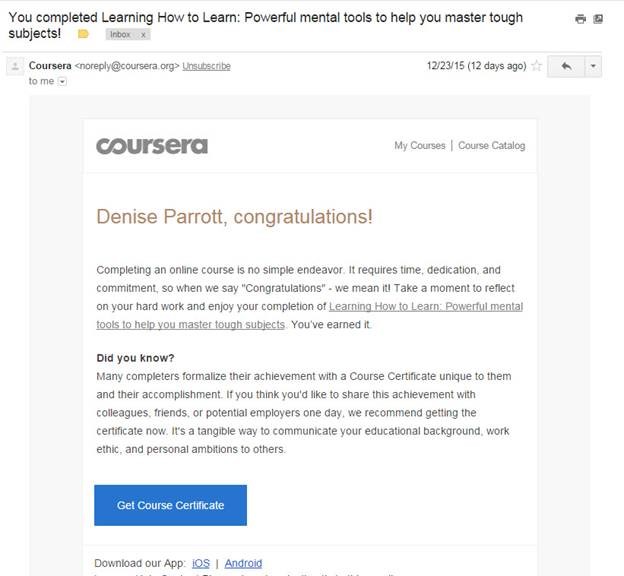I have just completed my second Coursera course, “A Life of Fulfillment and Happiness“, a 6-week program that surveyed the research on happiness. This course was filled with new learning and great ideas on how to learn, many of which mirrored the “Learning how to Learn” course I completed earlier. Being happy, as it turns out, makes us more creative and helps us be better learners.
The instructor reviewed the 7 happiness sins and how to counteract them. I’ve listed them below and added my personal goals, based on the “antidotes” he recommends:
1.Devaluing happiness – we tend to sacrifice happiness for things that don’t make us happy.
Personal goal: On a regular basis, record the things that make me happy so that I will remember to be happy in those situations.
2.Chasing superiority – This requires us to judge others and compare ourselves materialistically, moving us away from activities that make us happy.
Personal goal: Challenge myself to spend 2-3 hours a week to become better at what I enjoy, in order to seek “flow”. People are not threatened by those who are in a state of flow, so it brings happiness to others too.
3.Being needy/avoidant – The need to belong is wired into humans, and childhood neediness or avoidance is likely to follow us into adulthood, but if we are aware of our propensities, we can change them. Our minds calm down when we think beyond ourselves.
Personal goal: Practice “creative altruism” by finding opportunities to give to others in simple and fun ways.
4.Being overly controlling – We are wired to seek autonomy, but there is a tipping point. You have to choose love or control; you can’t have both. We must develop the skills to take personal responsibility for our own happiness and not had the “keys of our happiness” to someone else.
Personal goal: Continuously examine my lifestyle related to eating, movement and sleep, and actively examine my emotions.
5&6.Distrusting others/Distrusting life – While we are hardwired to be distrusting, the biggest determinant of happiness in a society is if people indicate they trust each other.
Personal goal: Actively anticipate the best outcomes but don’t judge what these outcomes end up being (“dispassionate pursuit of passion”).
7.Ignoring the “source within” – We are happier when we are mindful, when we observe our own emotions but don’t add or take away from situation. Mindfulness mitigates the other 6 sins.
Personal goal: Start with mindful practice for 1-2 minutes a day (even 5 minutes a day improves our working memory — which will help me be a better learner!).

